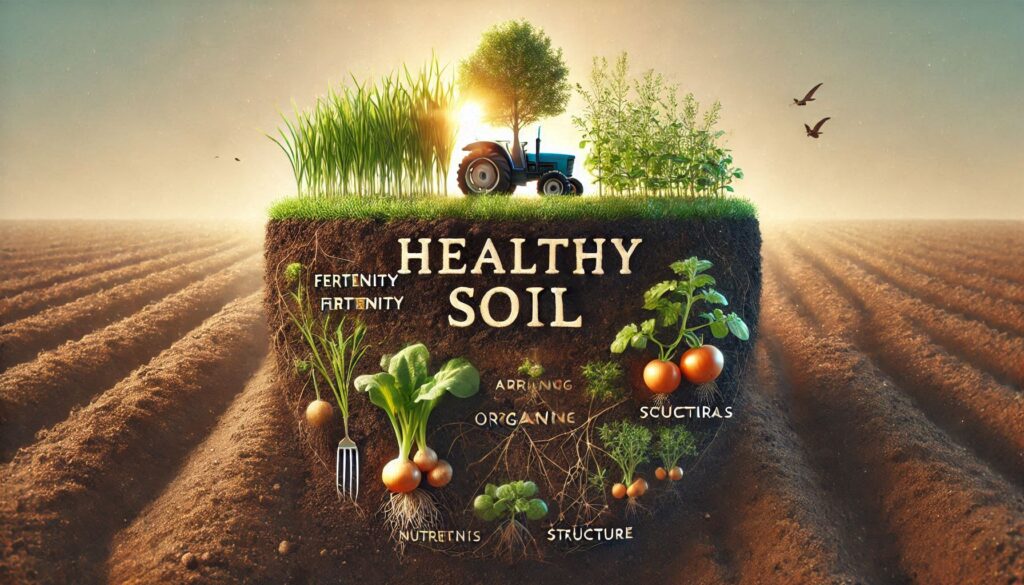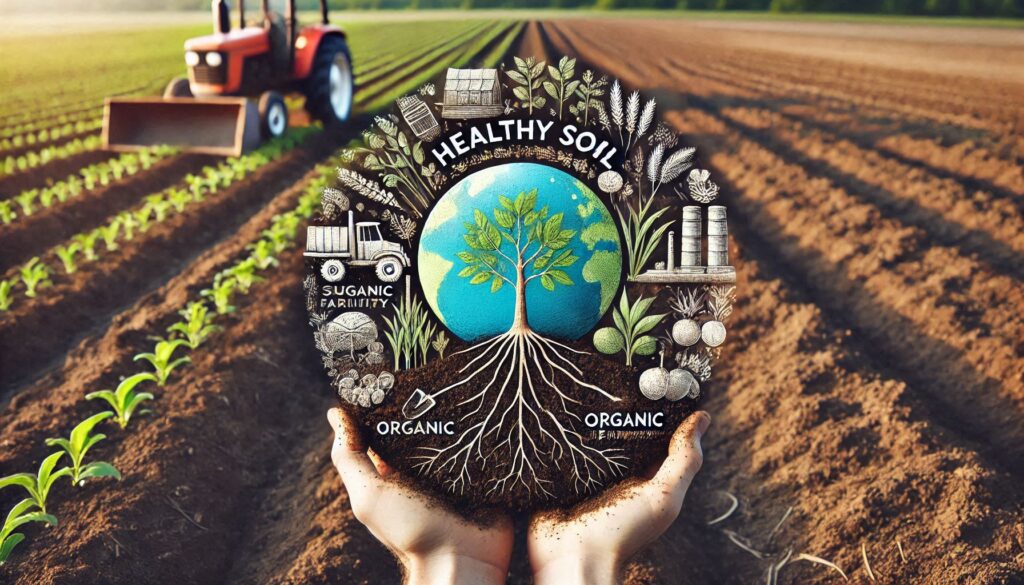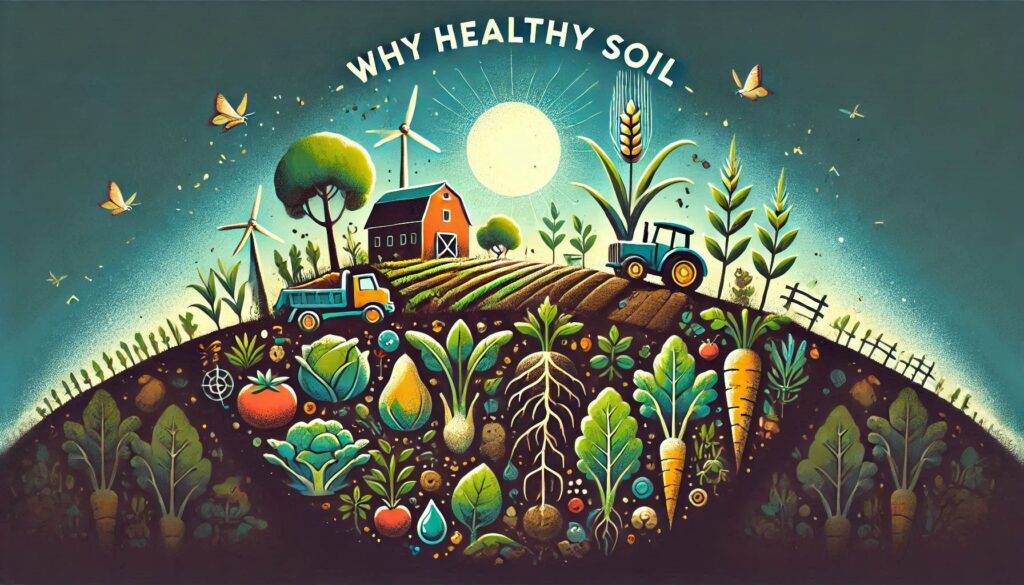Healthy soil is the foundation of successful organic farming. Often referred to as the “heart” of agriculture, soil serves as the medium where plants grow, nutrients are stored, and ecosystems thrive. In organic farming, the health and fertility of the soil are paramount, as synthetic chemicals are not used to compensate for poor soil quality. This blog delves into why healthy soil is essential for organic farming, exploring its fertility, structure, and the practices that enhance its vitality.

The Importance of Soil in Organic Farming
Soil is not just dirt; it is a living ecosystem filled with microorganisms, organic matter, minerals, and nutrients that sustain plant growth. In organic farming, soil health directly influences crop quality, yield, and resilience against pests and diseases. Unlike conventional farming, which may rely on synthetic inputs, organic farming depends on maintaining a balanced and thriving soil ecosystem.
Understanding Soil Fertility
1. Nutrient Content
Soil fertility refers to the ability of soil to provide essential nutrients to plants. Key nutrients like nitrogen (N), phosphorus (P), and potassium (K) are critical for plant growth. Organic farming emphasizes:
- Natural Nutrient Sources: Organic farmers use compost, animal manure, and green manure to enrich soil nutrient content.
- Microbial Activity: Healthy soil supports microorganisms that break down organic matter, releasing nutrients in forms plants can absorb.
2. Organic Matter
Organic matter is a vital component of fertile soil. It improves soil structure, enhances water retention, and serves as a food source for soil organisms. Organic farming practices aim to:
- Increase Organic Matter: Regularly adding compost and crop residues.
- Encourage Decomposition: Allowing soil microbes to naturally break down organic materials.

3. pH Balance
Soil pH affects nutrient availability. Organic farmers often use lime or sulfur to adjust soil pH, ensuring it remains within the optimal range for crop growth (typically 6.0 to 7.5).
The Role of Soil Structure in Farming
Soil structure refers to how soil particles are arranged. Good soil structure facilitates root penetration, water movement, and air circulation. In organic farming:
1. Porosity and Drainage
- Well-structured soil prevents waterlogging and ensures proper drainage.
- Organic practices like reduced tillage help maintain soil porosity.
2. Compaction Prevention
- Compacted soil restricts root growth and reduces oxygen availability.
- Organic farmers use cover crops and avoid heavy machinery to minimize compaction.
3. Erosion Control
- Soil erosion depletes topsoil, reducing fertility.
- Organic farming methods like contour plowing and mulching protect soil from erosion.
Practices That Promote Healthy Soil
1. Crop Rotation
Crop rotation involves planting different crops in a sequence to prevent nutrient depletion and reduce pest and disease cycles. For example:
- Legumes: Fix nitrogen in the soil, enriching its fertility.
- Deep-Rooted Crops: Break up compacted layers and improve soil structure.
2. Cover Cropping
Cover crops, like clover and rye, are planted during off-seasons to:
- Prevent erosion.
- Add organic matter when tilled into the soil.
- Suppress weeds naturally.
3. Composting
Composting transforms organic waste into a nutrient-rich amendment. Benefits include:
- Enhancing soil fertility.
- Improving water retention.
- Supporting microbial activity.
4. Reduced Tillage
Excessive tillage can disrupt soil structure and kill beneficial organisms. Organic farming encourages minimal tillage to:
- Preserve soil health.
- Retain organic matter.
- Reduce erosion risk.
5. Mulching
Mulching involves covering soil with organic or inorganic materials to:
- Retain moisture.
- Regulate soil temperature.
- Suppress weeds.
The Ecosystem Within the Soil
Healthy soil is teeming with life, from earthworms and insects to bacteria and fungi. This diverse ecosystem:
- Breaks Down Organic Matter: Recycling nutrients for plant use.
- Suppresses Pathogens: Competing with harmful organisms.
- Improves Soil Structure: Through the activity of organisms like earthworms.
Challenges in Maintaining Soil Health
While organic farming prioritizes soil health, challenges include:
1. Soil Degradation
Over-farming and improper practices can lead to loss of soil fertility. Organic farmers combat this with sustainable methods.
2. Nutrient Deficiency
Organic methods can sometimes take longer to replenish nutrients compared to synthetic fertilizers. Careful planning and crop selection are essential.
3. Climate Change
Extreme weather events, like droughts and floods, can impact soil structure and fertility. Organic farming’s focus on resilience helps mitigate these effects.
The Benefits of Healthy Soil in Organic Farming
1. Enhanced Crop Quality
Nutrient-dense soil produces higher-quality crops with better flavor and nutritional content.
2. Increased Resilience
Healthy soil helps plants withstand pests, diseases, and extreme weather conditions.
3. Environmental Benefits
- Reduces the need for chemical inputs.
- Supports biodiversity.
- Captures and stores carbon, mitigating climate change.

Conclusion
Soil is not merely a medium for growing plants; it is the lifeblood of organic farming. By nurturing soil health through sustainable practices, organic farmers ensure long-term productivity, environmental protection, and high-quality food production. Whether you’re a farmer or a consumer, understanding the importance of healthy soil underscores the value of organic farming in creating a more sustainable future.
What steps can you take to support soil health? Share your thoughts and ideas in the comments below!
Here are the top questions to ask people on organic farming, and related topics
- Why is soil considered the “heart” of organic farming?
- Soil provides essential nutrients, stores water, and supports ecosystems, making it central to successful organic farming.
- How does organic farming maintain soil fertility?
- Organic farming enriches soil through compost, manure, crop rotation, and supporting microbial activity for nutrient cycling.
- What role does soil structure play in organic farming?
- Good soil structure aids root growth, water movement, and air circulation, which is essential for healthy plant development.
- What are some practices that improve soil health in organic farming?
- Practices like crop rotation, cover cropping, composting, reduced tillage, and mulching enhance soil fertility and structure.
- What are the benefits of maintaining healthy soil in organic farming?
- Healthy soil improves crop quality, increases pests and climate change resilience, and supports environmental sustainability.



Pingback: Why Organic Farming is Better
Pingback: Why organic farming is not sustainable.
Pingback: Soil Health
Pingback: Why Organic Farming is Good (2025)